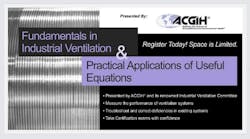The American Conference of Governmental Industrial Hygienists and its Industrial Ventilation Committee present a popular continuing education course this fall. “Fundamentals in Industrial Ventilation & Practical Applications of Useful Equations” will be held Nov. 6-10, 2017, at the DoubleTree Suites by Hilton Cincinnati-Blue Ash in Cincinnati.
The fundamentals portion of the course covers both basic and advanced topics related to industrial ventilation, including:
• The behavior of air and chemical contaminants in the air;
• Industrial process exhaust system design (including ACGIH calculation methods);
• Makeup and supply air ventilation systems;
• Dilution ventilation systems;
• Selection and design of exhaust hoods, ducts and fittings;
• Fans and air cleaners (including Fan Laws);
• Troubleshooting and testing of existing systems; and
• Hands-on testing and measurements.
The practical applications of the course closely follows ACGIH’s “Quantitative Industrial Hygiene: A Formula Workbook,” supplied to participants and includes:
• Calculation and estimation approaches related to airborne contaminants;
• TLV and TWA;
• OA for dilution, fans, system testing, sound and noise, heat stress, radiation, ventilation, statistics, chemistry, etc.; and
• A calculations lab in which participants work in a team environment.
This course contains 32 hours of instruction and may be eligible for American Board of Industrial Hygiene CM credit and/or Board of Certified Safety Professionals recertification points. Check the websites for credit criteria. Attendees will be presented with Certificates of Completion at the conclusion of the course.
Those interested in attending this continuing education course can register online here. Course dates for 2018 will soon be available.
Course participants will receive ACGIH’s “Industrial Ventilation: A Manual of Recommended Practice for Design, 29th Edition,” “Industrial Ventilation: A Manual of Recommended Practice for Operation and Maintenance,” and “Quantitative Industrial Hygiene: A Formula Workbook,” as well as the ACGIH Velocity Pressure Method Calculation Spreadsheet for performing calculations and equations covered in the primary workbooks provided with the course, including ventilation system design, a CD-ROM with copies of classroom PowerPoint presentations, copies of labs and exercises along with supplementary course materials, and course handouts.









